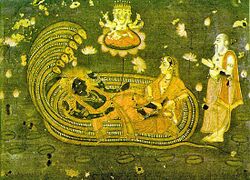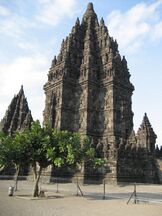| 三相神 | |
|---|---|
| 印度教三相 | |
| 天城體 | त्रिमूर्ति |
| 配偶 | 三女神 |
三相神(梵文:त्रिमूर्तिः trimūrti),在梵文中原意為「有三種形式」,是印度教的一個概念,「將宇宙的創造、維持和毀滅的功能分別人性化為創造者梵天,維護者或保護者毗濕奴,以及毀滅者或轉化者濕婆」 [1][2]。這三位神靈被認為是「印度教的三合一(the Hindu triad)」[3]或「偉大的三位一體」[4],或稱為「梵天-毗濕奴-濕婆」。也有人認為這種三個神靈互相獨立的理論,應該稱之為三位三體論,當三個神都合為一體時,這個化身被稱為Dattatreya。
- 答磨(暗,Tamas)表示無知、懶惰及靈性的黑暗,和毀滅之神濕婆有關。
- 羅闍(憂,Rajas)表示活動、熱情及新的開始,和梵天有關。
- 薩埵(喜,Sattva)表示純淨、友善及和諧,和毗濕奴有關。[5]
三德也對應三種顏色及地球的三個成份:答磨為黑色,對應地球上的火、羅闍為紅色,對應地球上的土、薩埵為白色,對應地球上的水。[5]
發展


在往世書時期(Puranic period,大約公元前300-1200年),後吠陀宗教和瑪茲穆德所謂的「綜合印度教(synthetic Hinduism)」逐漸興起。[6]這一時期印度各宗派還沒有同質化,繼承古老吠陀信仰傳統的正統古婆羅門教和其他在正統框架下的不同教派(知名的比如濕婆派、毗濕奴派、性力派)共存。[7]這一時期的重要特質之一就是正統派和其他宗派的和諧共存。[8]關於這種和諧共處的潮流,瑪茲穆德提到:
它的最值得關注的表現可以在三相神的宗教概念中發現,比如至高神的表現形式有三種形式:梵天、毗濕奴、濕婆……但是這種嘗試可能並不成功,因為梵天從沒有得到超出濕婆或毗濕奴的統治地位,不同的教派常常認為三相神是自己教派的主神的三種表現形式,認為本教派的主神是梵或絕對真理。[9]
莫里斯·溫特尼茨注意到印度文學中很少提到三相神。[10]《龜往世書》(Kūrma Purāṇa)十分強調梵天、毗濕奴、濕婆是同一神,而在第1.6節中梵被崇拜為三相神;第1.9節也特別反覆灌輸這三神的同一性;第1.26節也提到同樣的主題。[11]
歷史學家巴沙姆解釋三相神的背景時,提到西方對三位一體的興趣:
早期學習印度教的西方學生對與基督教類似的印度教的三位一體印象深刻。事實上這種類似並不夠緊密。不像基督教的三位一體,印度教的三位一體從沒有真正「流行起來(caught on)」。所有的印度教三位一體派都傾向於偏愛這三神中的某個神;因此,從這個背景來看,很明顯迦梨陀娑的獻給三相神的讚美詩實際上是獻給被認為是至高神的梵天的。三相神實際上是人為的拔高,並沒有太多的真正影響。[12]
弗里達·瑪切特(Freda Matchett)描述三相神系統為「多種神的形象可以在不同的層次被組合的框架」[13]
三相神的概念在彌勒奧義書也出現過,這裏三神被解釋為至高神的三種首要形式。[14]
印度教中的觀點
紹拉派
紹拉派(Sauram)崇拜太陽神蘇利耶為至高神,下梵不接受三相神。早期的三相神形式包括有蘇利耶而不是梵天,或者將蘇利耶作為高於三相神的至高神,認為三相神是蘇利耶的三種表現形式。蘇利耶在早上是梵天,下午是毗濕奴,晚上是濕婆。有些紹拉派崇拜毗濕奴或濕婆為蘇利耶的表現形式,另一些則膜拜三相神作為蘇利耶的表現形式,還有些僅僅專門崇拜蘇利耶。
毗濕奴派

毗濕奴派一般不接受三相神的概念。例如,二元論派堅持毗濕奴單獨是至高神,濕婆是下屬,對往世書有不同解釋。二元論派學者Vijayindra Tîrtha認為毗濕奴往世書(Vaishnavite puranas)是喜往世書,濕婆往世書(Shaivite puranas)是暗往世書,僅僅喜往世書(satvic puranas)是有權威的。[15]
濕婆派

濕婆派根據濕婆阿含經堅持,濕婆神有五個功能——創造,保護,毀滅,隱藏恩賜(concealing grace),顯露恩賜(revealing grace)。這五個功能每一個都對應濕婆的一個名字和形式。濕婆是至高神,三相神是濕婆的一種形式。[16]

傳統派
傳統派(Smartism)強調五神系統,而不是一個神[17]。9世紀哲學家商羯羅使得五神系統流行。該系統崇拜五個神靈——象頭神、毗濕奴、濕婆、提毗、蘇利耶[18][19]。商羯羅後來又加入室建陀,稱為六神。商羯羅推廣這個系統同一用以聯合以這六神為主要神的各大主要教派。[20]
參考文獻
引用
- ↑ For quotation defining the trimurti see Matchett, Freda. "The Purāṇas", in: Flood (2003), p. 139.
- ↑ For the Trimurti system having Brahma as the creator, Vishnu as the maintainer or preserver, and Shiva as the transformer or destroyer. see Zimmer (1972) p. 124.
- ↑ For definition of trimurti as "the unified form" of Brahmā, Viṣṇu and Śiva and use of the phrase "the Hindu triad" see: Apte, p. 485.
- ↑ For the term "Great Trinity" in relation to the Trimurti see: Jansen, p. 83.
- ↑ 5.0 5.1 Wolfgang Bauer, Irmtraud Dümotz, Sergius Golowin: Lexikon der Symbole. Heyne 2001
- ↑ For dating of Puranic period as c. CE 300-1200 and quotation, see: Majumdar, R. C. "Evolution of Religio-Philosophic Culture in India", in: Radhakrishnan(CHI, 1956), volume 4, p. 47.
- ↑ For characterization as non-homogeneous and including multiple traditions, see: Majumdar, R. C. "Evolution of Religio-Philosophic Culture in India", in: Radhakrishnan(CHI, 1956), volume 4, p. 49.
- ↑ For harmony between orthodox and sectarian groups, see: Majumdar, R. C. "Evolution of Religio-Philosophic Culture in India", in: Radhakrishnan(CHI, 1956), volume 4, p. 49.
- ↑ For quotation see: see: Majumdar, R. C. "Evolution of Religio-Philosophic Culture in India", in: Radhakrishnan(CHI, 1956), volume 4, p. 49.
- ↑ Winternitz, volume 1, p. 452, note 1.
- ↑ For references to Kūrma Purana see: Winternitz, volume 1, p. 573, note 2.
- ↑ Basham, pp. 310-311.
- ↑ Matchett, Freda. "The Purāṇas", in Flood (2003), p. 139.
- ↑ "Brahma, Rudra and Vishnu are called the supreme forms of him. His portion of darkness is Rudra. His portion of passion is Brahma. His portion of purity is Visnu" Maitri Upanisad [5.2]
- ↑ Sharma, B. N. Krishnamurti. A history of the Dvaita school of Vedānta and its literature: from the earliest beginnings to our own times. Motilal Banarsidass Publishers. 2000. ISBN 81-208-1575-0.
- ↑ How can the god of destruction be the Supreme ?. [2013-07-22].
- ↑ Flood (1996), p. 17.
- ↑ Dating for the pañcāyatana pūjā and its connection with Smārta Brahmins is from Courtright, p. 163.
- ↑ For worship of the five forms as central to Smarta practice see: Flood (1996), p. 113.
- ↑ Grimes, John A. Ganapati: Song of the Self. SUNY Series in Religious Studies. Albany: State University of New York Press. 1995: p.162. ISBN 0-7914-2440-5.
來源
- 書籍
- Apte, Vaman Shivram. The Practical Sanskrit Dictionary Fourth revised and enlarged. Delhi: Motilal Banarsidass Publishers. 1965. ISBN 81-208-0567-4.
- Basham, A. L. The Wonder That Was India: A Survey of the Culture of the Indian Sub-Continent Before The Coming of the Muslims. New York: Grove Press, Inc.,. 1954.
- Flood, Gavin (Editor). The Blackwell Companion to Hinduism. Malden, MA: Blackwell Publishing Ltd. 2003. ISBN 1-4051-3251-5.
- Jansen, Eva Rudy. The Book of Hindu Imagery. Havelte, Holland: Binkey Kok Publications BV. 2003. ISBN 90-74597-07-6. Eighth printing; First published 1993.
- Radhakrishnan, Sarvepalli (Editorial Chairman). The Cultural Heritage of India. Calcutta: The Ramakrishna Mission Institute of Culture. 1956. Second edition, four volumes, revised and enlarged, 1956 (volume IV).
- Winternitz, Maurice. History of Indian Literature. New Delhi: Oriental Books Reprint Corporation. 1972. Second revised reprint edition. Two volumes. First published 1927 by the University of Calcutta.
- Zimmer, Heinrich. Myths and Symbols in Indian Art and Civilization. Princeton, New Jersey: Princeton University Press. 1972. ISBN 0-691-01778-6.